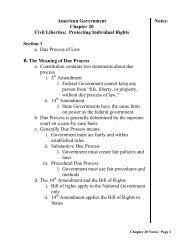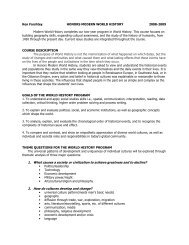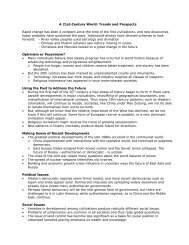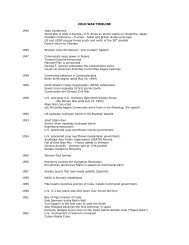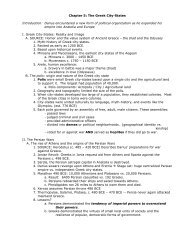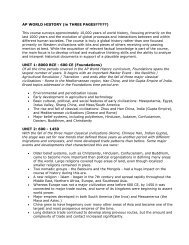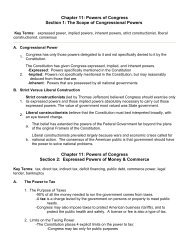Triangle Shirtwaist Factory Fire
Triangle Shirtwaist Factory Fire
Triangle Shirtwaist Factory Fire
- No tags were found...
You also want an ePaper? Increase the reach of your titles
YUMPU automatically turns print PDFs into web optimized ePapers that Google loves.
<strong>Triangle</strong> <strong>Shirtwaist</strong> <strong>Factory</strong> <strong>Fire</strong>(March 25, 1911)From Lovell,Moberly,Watkins,Esqs.MSHSSweatshopIndustries,Inc.
The <strong>Triangle</strong> <strong>Shirtwaist</strong><strong>Factory</strong> fire in New York Cityon March 25, 1911, was thelargest industrial disaster inthe history of the city of NewYork, causing the death of 146garment workers who eitherdied in the fire or jumped totheir deaths. The fire led tolegislation requiringimproved factory safetystandards and helped spurthe growth of theInternational Ladies'Garment Workers' Union,which fought for betterworking conditions forsweatshop workers in thatindustry.
The <strong>Triangle</strong> <strong>Shirtwaist</strong> Company, owned by Max Blanck and Isaac Harris, occupied the top threefloors of the ten-story Asch building in New York City at the intersection of Greene Street andWashington Place, just east of Washington Square.The company employed approximately 500 workers, mostly young immigrant women from Italyand Eastern Europe. Some of the women were as young as twelve or thirteen and worked fourteenhourshifts during a 60-hour to 72-hour workweek, sewing clothes for a wage of $1.50 per week(approximately $31 per week in 2006 dollars).
The <strong>Triangle</strong> <strong>Shirtwaist</strong> Company had already become well-known outside the garmentindustry by 1911: the massive strike by women's shirtwaist makers in 1909, known as theUprising of 20,000, began with a spontaneous walkout at the <strong>Triangle</strong> Company.
While the InternationalLadies' Garment Workers'Union negotiated acollective bargainingagreement covering mostof those workers after afour-month strike,<strong>Triangle</strong> <strong>Shirtwaist</strong>refused to sign theagreement.
The conditions of thefactory were typical ofthe time. Flammabletextiles were storedthroughout the factory,scraps of fabric litteredthe floors, patterns anddesigns on sheets oftissue paper hungabove the tables,smoking was common,illumination wasprovided by open gaslighting, and therewere no fireextinguishers.
In the afternoon of March 25, 1911, a fire began on the eighth floor, possibly sparked by a lighted matchor a cigarette. A New York Times article also theorized that the fire may have been started by theengines running the sewing machines in the building. To this day, no one knows whether it wasaccidental or intentional. Most of the workers who were alerted on the tenth and eighth floors were ableto evacuate. However the warning about the fire did not reach the ninth floor in time.
The ninth floor had onlytwo doors leading out.One stairwell was alreadyfilling with smoke andflames by the time theseamstresses realized thebuilding was ablaze. Theother door had beenlocked, ostensibly toprevent workers fromstealing materials ortaking breaks and to keepout union organizers.
The single exterior fireescape, a flimsy, poorlyanchorediron structure, soontwisted and collapsed underthe weight of people trying toescape. The elevator alsostopped working, cutting offthat means of escape, partlybecause the panickedworkers tried to savethemselves by jumping downthe shaft to land on the roofof the elevator.
Realizing there was no other way to avoid the flames, sixty-two of the women broke windowsand jumped to the pavement nine floors below. Others pried open the elevator doors andtumbled down the elevator shaft. Of the jumpers, a single survivor was found close to drowningin water collecting in the elevator shaft. The fallen bodies and falling victims made it difficultfor the fire department to reach the building.The remainder waited until smoke and fire overcame them. The fire department arrived quicklybut was unable to stop the flames, as there were no ladders available that could reach beyondthe sixth floor. The death toll was 146.
The company's owners, Max Blanck and Isaac Harris, had fled to the building's roof when thefire began and survived. They were later put on trial, at which Max Steuer, counsel for thedefendants, managed to destroy the credibility of one of the survivors, Kate Alterman, byasking her to repeat her testimony a number of times — which she did, without altering a singleword. Steuer argued to the jury that Alterman and probably other witnesses had memorizedtheir statements and might even have been told what to say by the prosecutors. The defensealso stressed that the prosecution had failed to prove that the owners knew the exit doors werelocked at the time in question. The jury acquitted the owners. However, they lost a subsequentcivil suit in 1913, and plaintiffs won compensation in the amount of $75 per deceased victim.
Cartoon pointing out the horrid working conditions at <strong>Triangle</strong> <strong>Shirtwaist</strong> <strong>Factory</strong>
Cartoon point out the corruption inherent in the inspectionof the <strong>Triangle</strong> <strong>Shirtwaist</strong> <strong>Factory</strong> by city officials.
<strong>Fire</strong>fighters returned the few belongings they could find.
Picture taken soon after fire was extinguished on ninth floor.
Picture taken after clean up began on the ninth floor.
A family member walks out of temporary morgue after viewing remains of victim




